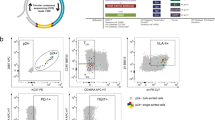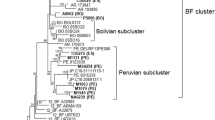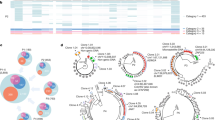Abstract
THE striking similarity between the first two human immunodeficiency virus type 1 (HIV-1) isolates Lai/LAV (formerly LAV, isolated at the Pasteur Institute1,2) and Lai/IIIB (formerly HTLV-IIIB, reported to be isolated from a pooled culture at the Laboratory of Tumor Cell Biology (LTCB) of the National Cancer Institute3,4) provoked considerable controversy in light of the high level of variability found among subsequent HIV-1 isolates5. In November 1990, the Office of Scientific Integrity at the National Institutes of Health commissioned our group to analyse archival samples established at the Pasteur Institute and LTCB between 1983 and 1985. Retrospective analyses6,7 have shown that contamination of a culture derived from patient BRU by one from patient LAI was responsible for the provenance of HIV-1 Lai/LAV; the contaminated culture (M2T-/B) was sent to LTCB in September 19836,7. Our goals were to determine which HIV-1 variants were present in the samples and the sequence diversity among HIV-1 isolates from the earliest stages of the AIDS epidemic. We examined archival specimens and report here the detection of six novel HIV-1 sequences in the cultures used to establish the pool: none is closely related to HIV-1 Lai/IIIB. A sample derived from patient LAI contained variants of both HIV-1 Lai/IIIB and HIV-1 Lai/LAV, and a sequence identical to a variant of HIV-1 Lai/IIIB was detected in the contaminated M2T-/B culture. We conclude that the pool, and probably another LTCB culture, MoV, were contaminated between October 1983 and early 1984 by variants of HIV-1 Lai from the M2T-/B culture. Therefore, the origin of the HIV-1 Lai/IIIB isolate also was patient LAI.
This is a preview of subscription content, access via your institution
Access options
Subscribe to this journal
Receive 51 print issues and online access
$199.00 per year
only $3.90 per issue
Buy this article
- Purchase on SpringerLink
- Instant access to full article PDF
Prices may be subject to local taxes which are calculated during checkout
Similar content being viewed by others
References
Barré-Sinoussi, F. et al. Science 220, 868–871 (1983).
Wain-Hobson, S., Sonigo, P., Danos, O., Cole, S. & Alizon, M. Cell 40, 9–17 (1985).
Popovic, M., Sarngadharan, M. G., Read, E. & Gallo, R. C. Science 224, 497–500 (1984).
Ratner, L. et al. AIDS Res. hum. Retrovir. 3, 57–69 (1987).
Myers, G., Rabson, A. B., Berzofsky, J. A., Smith, T. F. & Wong-Staal, F. Human Retroviruses and AIDS (Los Alamos National Laboratory, Los Alamos, NM, 1991).
Wain-Hobson, S. et al. Science 252, 961–965 (1991).
Guo, H.-G. et al. Nature 349, 745–746 (1991).
Goodenow, M. et al. J. AIDS 2, 344–352 (1989).
Ratner, L. et al. Nature 313, 277–283 (1985).
Muesing, M. A. et al. Nature 313, 450–458 (1985).
Adachi, A. et al. J. Virol. 59, 284–291 (1986).
Saiki, R. K. et al. Science 230, 1350–1354 (1985).
Saiki, R. K., Walsh, P. S., Levenson, C. H. & Erlich, H. A. Proc. natn. Acad. Sci. U.S.A. 86, 6230–6234 (1989).
Schüpbach, J. & Popovic, M. Science 224, 503–505 (1984).
Hahn, B. H. et al. Science 232, 1548–1553 (1986).
Balfe, P., Simmonds, P., Ludlam, C. A., Bishop, J. O. & Leigh Brown, A. J. J. Virol. 64, 6221–6233 (1990).
Wolfs, T. et al. Proc. natn. Acad. Sci. U.S.A. 87, 9938–9942 (1990).
Li, W.-H., Tanimura, M., & Sarp, P. M. Molec. biol. Evol. 5, 313–330 (1988).
Burger, H. et al. Proc. natn. Acad. Sci. U.S.A. 88, 11236–11240 (1991).
Wolinsky, S, M. et al. Science 255, 1134–1137 (1992).
Kellogg, D. E. & Kwok, S. in PCR Protocols: A Guide to Methods and Applications 337–347 (Academic, San Diego, 1990).
Longo, M. C., Berninger, M. S. & Hartley, J. L. Gene 93, 125–128 (1990).
Kwok, S. Y. in PCR Protocols: A Guide to Methods and Applications 142–145 (Academic, San Diego, 1990).
Kawasaki, E. S. in PCR Protocols: A Guide to Methods and Applications 146–152 (Academic, San Diego, 1990).
Chang, S.-Y., Shih, A., & Kwok, S. in Molecular Evolution: Producing the Biochemical Data (Academic, Orlando, in the press).
Erlich, H. A., Gelfand, D., & Sninsky, J. J. Science 252, 1643–1651 (1991).
Saitou, N. & Nei, M. Molec. biol. Evol. 4, 406–425 (1987).
Author information
Authors and Affiliations
Rights and permissions
About this article
Cite this article
Chang, SY., Bowman, B., Weiss, J. et al. The origin of HIV-1 isolate HTLV-IIIB. Nature 363, 466–469 (1993). https://doi.org/10.1038/363466a0
Received:
Accepted:
Issue Date:
DOI: https://doi.org/10.1038/363466a0
This article is cited by
-
Fast and sensitive detection of SARS-CoV-2 RNA using suboptimal protospacer adjacent motifs for Cas12a
Nature Biomedical Engineering (2022)
-
HIV-1 Tat second exon limits the extent of Tat-mediated modulation of interferon-stimulated genes in antigen presenting cells
Retrovirology (2014)
-
Protecting HIV databases
Nature (1995)




